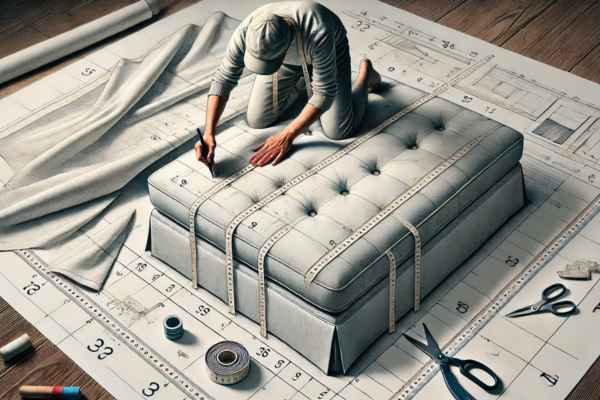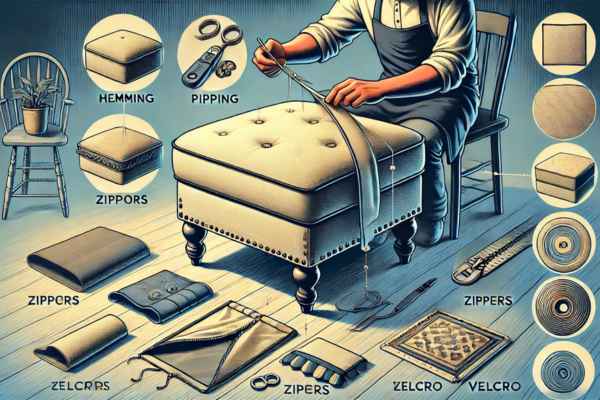A slipcover is an excellent way to refresh the look of your ottoman without the need to buy a new piece of furniture. Whether you want to protect your ottoman from wear and tear or simply update its style, a custom can provide a tailored look that enhances your living space. Making a slipcover for an ottoman is a rewarding DIY project that allows you to personalize your furniture according to your taste and needs. In this guide, we’ll walk you through the steps needed to create a stylish and functional, ensuring a perfect fit and a professional finish.
Materials And Tools Needed

Before you begin, it’s essential to gather all the necessary materials and tools to ensure a smooth crafting process. You’ll need fabric that compliments your décor, sewing supplies such as needles, thread, and scissors, as well as measuring tape to get accurate dimensions of your ottoman. Additionally, a sewing machine will make the process faster and more efficient, although hand-sewing is also an option. Other helpful tools include pins, a fabric marker or chalk for tracing patterns, and possibly an iron for pressing seams and hems. Having everything ready at the start will save time and help you focus on the creative aspects of the project.
Measuring Your Ottoman

Accurate measurements are crucial for creating a slipcover that fits snugly and looks professionally made. Start by measuring the height, width, and depth of your ottoman. It’s essential to measure each dimension carefully, taking into account any curves or unique shapes the ottoman might have. Note these measurements down and double-check them to avoid any mistakes. Remember, precise measurements will ensure that the fits perfectly, avoiding any loose or tight spots that could detract from its appearance.
Choosing The Right Fabric

Selecting the right fabric is key to creating a slipcover that is both durable and aesthetically pleasing. Consider the room’s color scheme and the ottoman’s use when choosing your. For a heavily used ottoman, you might opt for a heavy-duty fabric like canvas or denim, which can withstand regular wear. On the other hand, if the ottoman is more decorative, lighter like linen or cotton can add a soft, elegant touch. Additionally, think about the ease of washing; choosing a fabric that is machine washable will make maintenance much easier. The right will not only enhance the look of your ottoman but also ensure that it lasts for years to come.
Cutting The Fabric

Once you’ve chosen the fabric and measured your ottoman, the next step is cutting the to match those measurements. Lay your fabric out on a flat surface and use your measurements to mark the sections you’ll need. It’s important to add a seam allowance, typically about 1/2 to 1 inch, around the edges of each piece to ensure that your slipcover has room for stitching. Carefully cut the along the lines you’ve marked, keeping your hand steady to avoid any uneven edges. Precise cutting is crucial because it forms the foundation for the entire, ensuring that each piece fits together seamlessly when you start sewing.
Sewing The Slipcover
With your fabric pieces cut to size, it’s time to begin sewing them together. Start by pinning the pieces together, right sides facing each other, to hold them in place as you sew. Begin stitching along the edges, following the seam allowance you included during the cutting stage. Use a straight stitch on your sewing machine, or hand-sew if you prefer, to create strong, durable seams. Pay special attention to corners and curves, sewing slowly and carefully to maintain a smooth line. Once all pieces are sewn together, you’ll have a that resembles the shape of your ottoman, ready for fitting.
Fitting And Adjusting

After sewing the slipcover, it’s time to fit it onto your ottoman. Carefully slide the cover over the ottoman, ensuring that it aligns with all the corners and edges. At this stage, you may notice areas that need slight adjustments, such as excess or tight spots. Mark these areas with pins or fabric chalk, then remove them and make the necessary adjustments by re-sewing or trimming as needed. This fitting process is crucial for achieving a snug, tailored look that will give your ottoman a polished appearance. Taking the time to adjust and perfect the fit will ensure that your slipcover looks professionally made.
Adding Finishing Touches

The final step in making a slipcover for your ottoman is adding the finishing touches that will enhance both its appearance and durability. This may include hemming the bottom edge of the to prevent fraying and create a clean finish. You might also want to add decorative elements such as piping, trim, or buttons to give the slipcover a unique, personalized look. If you prefer a more secure fit, consider adding ties, zippers, or Velcro closures to the slipcover. These small details not only contribute to the overall aesthetic but also ensure that your stays in place and lasts longer, providing a beautiful and functional addition to your home.
Care And Maintenance
Once your slipcover is complete, proper care and maintenance will ensure it remains in excellent condition. Most can be machine washed, but it’s crucial to follow the specific care instructions for the you’ve chosen. Regular washing will keep the slipcover looking fresh and clean, while spot cleaning can address any immediate spills or stains. To prevent fading and wear, consider rotating the if your ottoman is used frequently. Additionally, ironing the slipcover after washing can help maintain its crisp appearance, especially if it’s made from a fabric prone to wrinkling. By taking these steps, you’ll prolong life and keep your ottoman looking stylish and well-kept.
Common Challenges And Solutions
Making a slipcover for an ottoman presents several challenges, but with some planning, you can easily overcome these. One common issue is bunching or uneven seams, which you can resolve by taking extra care during the measuring and cutting stages. When you ensure that all measurements are accurate and that fabric pieces are cut precisely, you will prevent most fitting problems. Another challenge is sewing corners and curves, which can be tricky to navigate. Sewing slowly and using plenty of pins to hold them in place can help you achieve smooth, professional-looking seams. If you encounter difficulties with fitting, small adjustments like trimming excess fabric or resewing tight areas can make a significant difference in the final result.
What Type Of Fabric Is Best For A Slipcover?
The best for a slipcover depends on the intended use of the ottoman and the desired aesthetic. For durability, especially in high-traffic areas, heavy-duty fabrics like canvas, denim, or twill are excellent choices. These materials are robust enough to withstand daily wear and tear, making them ideal for family rooms or ottomans that double as footrests. If comfort and style are your priorities, consider softer fabrics like linen, cotton, or a cotton blend, which offer a more luxurious feel and a wide range of colors and patterns. For easy maintenance, choosing a machine-washable is recommended, especially in households with children or pets. Ultimately, the best fabric is one that balances durability, comfort, and style to suit your specific needs.
Can I Make A Slipcover For A Round Or Irregularly Shaped Ottoman?
Yes, you can make a slipcover for a round or irregularly shaped ottoman, although it may require a bit more planning and effort. The key is to take precise measurements and create a custom pattern that accounts for the unique shape of your ottoman. For round ottomans, measuring the diameter and height is essential, and cutting the fabric in sections that will join smoothly is crucial for a neat finish. Irregularly shaped ottomans may require more detailed measurements and adjustments, but with careful attention to detail, you can create a that fits perfectly. Using a stretchy can also help accommodate unusual shapes, as it will conform more easily to the contours of the ottoman. With patience and precision even a non-standard ottoman can be beautifully slipcovered.
How Do I Know How Much Fabric To Buy?
Determining the right amount of fabric for your slipcover is crucial to ensuring you have enough material without excess waste. Start by measuring each part of your ottoman, including the top, sides, and any additional features like skirts or ruffles. Add these measurements together, taking into account the need for seam allowances, typically around 1/2 to 1 inch per edge. If you have a pattern, you’ll also need to allow extra fabric to match the pattern across seams, which can prevent the final product from looking mismatched. Once you have your total measurement, consult with your store or use an online calculator to determine how many yards you’ll need based on the width of the fabric roll. It’s always a good idea to purchase a little extra to account for any mistakes or future repairs.
What If My Slipcover Doesn’t Fit Perfectly?
Your slipcover doesn’t fit perfectly, don’t worry—there are several ways to correct the issue. First, identify where the fit is off. If the is too loose, you can take in the seams by sewing closer to the edges, which will tighten the fit. Conversely, if it’s too tight, consider letting out some seams or adding fabric panels to provide extra room. For minor adjustments, using Velcro strips, ties, or elastic bands can help secure the slipcover more snugly to the ottoman. If the issue is with the overall shape, such as uneven corners or puckering, carefully re-sewing those areas with a more precise stitch can make a significant difference. Adjustments and tweaks are often necessary, so don’t hesitate to make changes until they fit to your satisfaction.
Conclusion
Creating a slipcover for your ottoman is a rewarding project that can breathe new life into your furniture while showcasing your personal style. By carefully measuring, cutting, and sewing your chosen fabric, you can craft a custom that fits your ottoman perfectly, whether it’s a standard square or a uniquely shaped piece. If challenges arise, they can be overcome with patience and attention to detail, resulting in a beautiful, durable slipcover. With the added benefit of easy maintenance and the ability to refresh your décor, a is an excellent DIY project for anyone looking to enhance their living space. So gather your materials, follow the steps, and enjoy the satisfaction of transforming your ottoman into a stylish and functional piece of furniture.
